- Baby Ochre Sea Star
- Tube Feet
- Blood Star eating clam
- Equal Star
- Leather Star
- Ochre Sea Stars
- Sunflower Star
How can a creature that moves just slightly faster than a snail, lacks a brain or blood, is unable to control its body temperature, finds food only because it happens to accidentally slide over the top of it, and spends most of its life clinging to rocks teach us anything about the beauty and complexity of life? Well stay tuned. The animal in question is one of the true stars of our Northwest wildlife. In fact, our shore line harbors more of these fascinating creatures than any other shoreline on earth.
About 2,000 species of sea stars inhabit our planet. At slightly less than three quarters of an inch, Leptychaster propinquus is the smallest. The largest reported sea star is the yard long Giant Star, Evasterias echinosoma, found in deep waters of the far north Pacific. The racehorse of the echinoderms is are very own Sun Star, Pycnopodia helinathoides. Barreling along at three tenths of a mile per hour they actually are quite speedy in the sea star realm. Should you ever have the pleasure of watching one of these big stars slide along the ocean floor it really does seem to move quickly.
Sea stars belong to a phylum of invertebrates called the Echinoderms which includes sea urchins, sand dollars, and the sea cucumbers. The most obvious characteristic of the echinoderms is their “radial symmetry,” meaning, if you slice one down the middle you end up with two halves that are mirror images of each other. To be more exact most exhibit pentamerous radial symmetry: a body divided into five parts structured around a central core. Echinoderms have an internal skeleton composed of calcerous ossicles. These tightly articulating ossicles serve basically the same function as our skeleton but also extend to the outer dermis of the animal, hence the meaning of the name echinoderm – “spiny skin.”
Sea stars make up the class Asteroidea. Although found throughout the world the highest density of them are found from Puget Sound in Washington state to the Aleutian Islands of Alaska. As noted before most have five radial arms but there are a number of exceptions, most notably the Sun Star that can boast up to 40 arms.
With the possible exception of orcas, sea stars are our most famous northwest wildlife residents. Their vivid colors, magical shape, and relatively easy access for observation have made them a sea shore favorite for all ages. Yet despite the fact that they are instantly recognized and quite common these invertebrate creatures have a number of unusual and unknown characteristics.
There is no actual sea star “brain.” Instead they possess a nerve ring with extensions that branch out into each arm. This is a remarkable arrangement considering the thousands of tube feet that it must control via a complex water vascular system. Unique to all echinoderms this dense network of canals is especially well developed in the Asteroidea. Turn one of these guys over sometime and you have to marvel at the thousands of tiny appendages covering the bottom of the animal. Now consider that each and every one of those tiny feet has a balloon like structure attached to it. When this “balloon” is squeezed the tube foot moves. This is hydraulics on the micro level; and all this controlled by a couple of simple nerve rings.
Sea stars are blind by our standards but they do have eyes. This comes as a surprise to most. The eyes are found at the very end of their arm. of Their precise function is unknown but they are believed to serve mainly as light sensors. The eye spot is found on the end of each arm.
Your ads will be inserted here by
Easy Plugin for AdSense.
Please go to the plugin admin page to
Paste your ad code OR
Suppress this ad slot.
The regeneration ability of sea star arms is well known. But sea stars can regenerate themselves completely. Cut one in half and the result is two sea stars. Even more amazing is that cutting the animal in fifths may result in five sea stars! Studies have proven that as long as a certain portion of the central disk remains attached to an arm the entire animal can regenerate. This ability is very useful, of course, during asexual reproduction. Although the majority reproduce sexually some species divide themselves in half to reproduce. One fascinating representative of these animals can actually cast off its own arms. The self-severed arm then regenerates an entirely new sea star!
Now all this might be odd enough for any one animal but the sea star has another trick up its tube feet. Depending on which direction the echinoderm is headed in the particular arm leading the way takes over as the dominant “brain” of the animal. Each arm, you see, has a nerve center of its own. So what would cause a sea star to activate its many thousands of feet in a certain direction to begin with? Food, of course. Sea stars are predators and scavengers. These guys will eat just about anything they can overwhelm. They detect food by scent in the water and considering the un-cheetah like locomotion of sea stars it is not surprising that many prefer bivalves – clams, oysters, etc. Their method of attack is to grasp the bivalve shell between its arms and then apply force to open the shell. The attack is relatively swift; a surprisingly tiny opening does the trick. As soon as this is accomplished the sea star extends its own stomach into the now exposed, fleshy part of its prey.
As you may well imagine this part of sea star biology does not endear it to oyster farmers. And if you need proof of their considerable appetite for clams take a trip to Cannon Beach, Oregon. There you can witness first hand just how voracious these echinoderms are as they scour huge boulders free of California mussels.
These beautiful animals do not start out life in the form we are so familiar with. Larvae are tiny, almost octopus shaped creatures with a sucker mouth and small larval arms. Microscopic sized cilia direct food into its mouth. Slowly the familiar adult body begins to take shape as its larval mouth and other body parts either degenerate or transform. The average life span is about ten years but some species may approach the ripe old age of forty.
References:
Invertebrate Zoology, Rupert and Barnes 6th edition (this is an absolutely wonderful book)
Whelks to Whales 2004, Rick M. Harbo, Habour Publishing (one of the best field guides for Northwest coastal life)
National Audubon Society Field Guide to North American Seashore Creatures

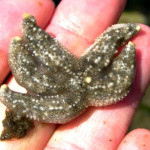
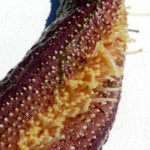
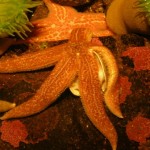
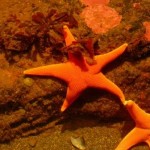
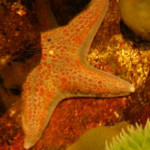
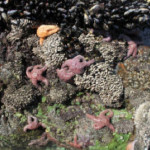
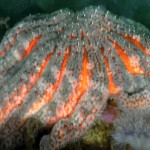
Leave a Reply
You must be logged in to post a comment.